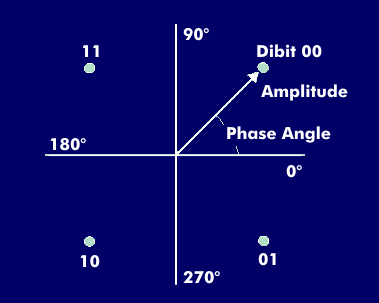quadrature phase shift keying (QPSK)
Quadrature phase shift keying (QPSK) uses four discrete phase positions for the shift keying. The digital signal is resampled in the four phase states of 45 degrees, 135 degrees, 225 degrees, and 315 degrees. Each phase state represents two combined bits, a dibit. If the dibit 00 is at a phase angle of 45 degrees, then the dibit 11 is at 135 degrees, the one for 10 is at 225 degrees, and the one for 01 is at 315 degrees.
With this four-phase keying, the transmission speed is doubled compared to two-phase keying. A disadvantage is that the phase change can be 180 degrees, namely when the dual value changes from 00 to 10, for example.
Since the phase-shifted signals pass through a low-pass filter in the transmitters, such phase shifts are distorted in amplitude, which can lead to errors in the transmission. In addition, the amplitude of the carrier frequency drops to zero at the moment when the phase change passes through zero. This can affect the synchronization of the receiving equipment. This disadvantage is eliminated by OQPSK keying (Offset Quadrature PhaseShift Keying). QPSK technology is used in directional radio, satellite communications, digital radio, Bluetooth, WLANs, cable modems and many other transmission technologies.

